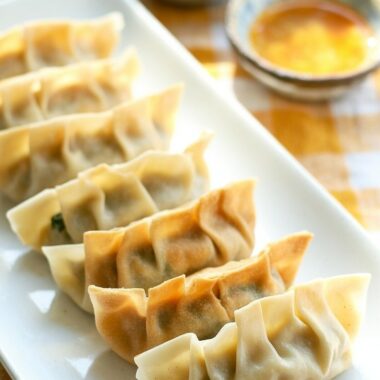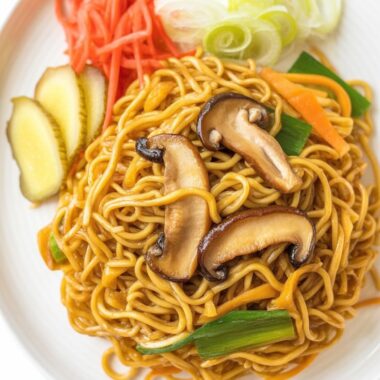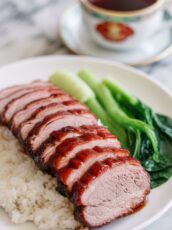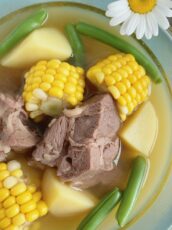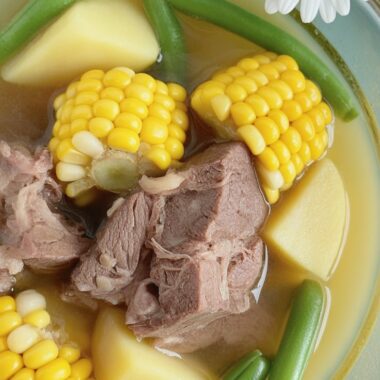Kimchi isn’t just a recipe — it’s tradition, memory, and everyday comfort food rolled into one. I grew up watching my mother and her friends gather for kimjang, the big annual kimchi-making session to prepare for winter. They would line up baskets of napa cabbage, work in a rhythm only years of practice can create, and fill every container in the house with bright red, spicy-scented cabbage.
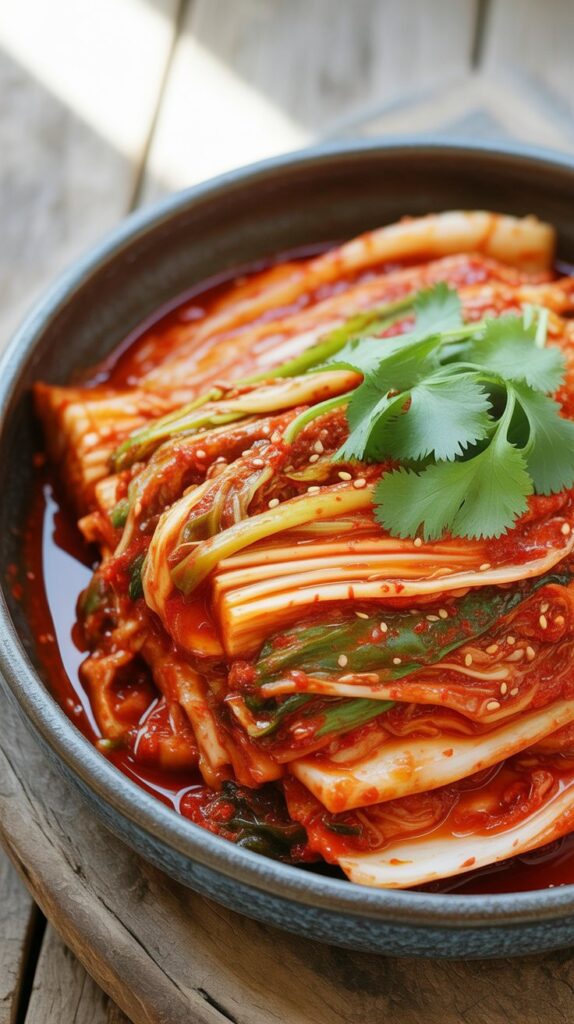
Today, I make smaller batches — usually 5 to 10 heads at a time — and I still share them with my grown-up kids, just like my mother and mother-in-law did for us. It’s a tradition I treasure, and in a Korean home, there’s no such thing as too much kimchi.
What Is Kimchi?
Kimchi (김치) is a Korean term for salted, seasoned, and fermented vegetables. There are hundreds of varieties, but this recipe is for baechu (napa cabbage) kimchi, also called pogi kimchi because the cabbage is kept intact in “heads” (pogi).
Beyond its cultural importance, kimchi is a probiotic powerhouse, full of lactic acid bacteria, antioxidants, and a flavor that develops and deepens as it ferments. You can enjoy it fresh for a mild, crunchy bite or let it age for a tangier, more complex taste.
Choosing the Right Napa Cabbage
For the best flavor and texture, pick medium to large napa cabbages around 5–5 ½ pounds, with firm, pale white stems and fresh, slightly light-green outer leaves. When you slice it, the white core should be straight and not overly thick, and the inner leaves should have a bright yellow hue.
The Salt That Makes the Difference
Korean coarse sea salt (cheonilyeom, 천일염) is the traditional choice for salting kimchi. Its coarse texture and clean, mild flavor help draw moisture from the cabbage while developing a more rounded, pleasant taste during fermentation.
If you only have fine table salt, use about 25% less than the recipe calls for, as it’s stronger and can make the cabbage overly salty.
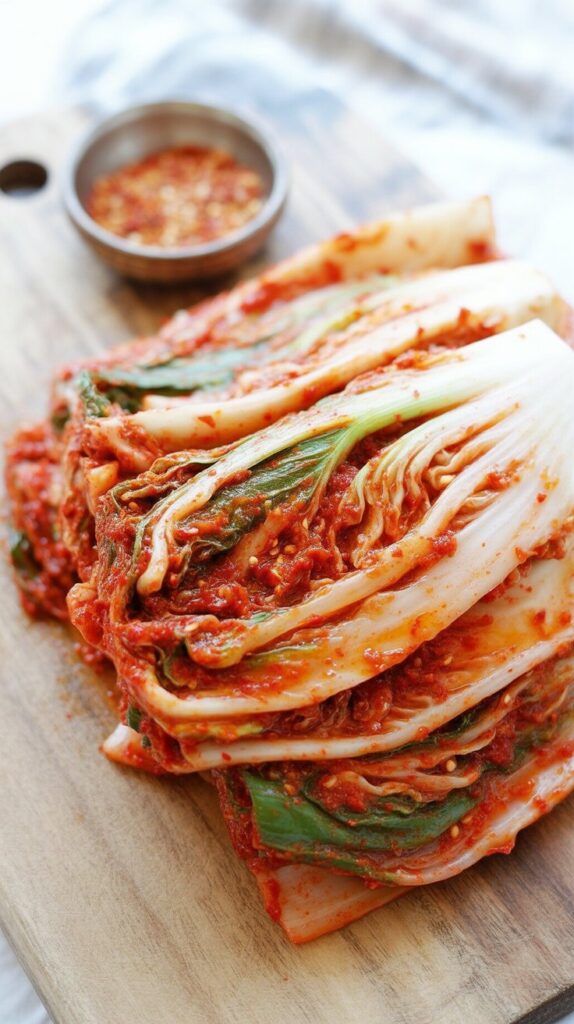
Seasonings for Traditional Kimchi
Every family has its own balance of flavors, but the basics include:
- Gochugaru (Korean red chili flakes) – Gives kimchi its signature color and heat.
- Garlic & Ginger – Freshly minced for brightness and depth.
- Jeotgal (salted seafood) – Usually saeujeot (salted shrimp) and myulchiaekjeot (anchovy fish sauce) for umami and to help fermentation.
- Radish – Julienned and mixed into the seasoning paste for texture and crunch.
My mother’s secret was adding a few fresh shrimp for a cleaner, fresher note — something I still do when I can find them. For vegan kimchi, simply skip the shrimp and replace fish sauce with soup soy sauce.
How to Make Kimchi at Home
- Prep the cabbage: Cut into halves or quarters. Rinse and bathe each piece in salt water, then sprinkle extra salt between the thicker stems.
- Let it brine: The cabbage should soften slightly and bend without breaking.
- Make the paste: Combine gochugaru, garlic, ginger, fish sauce, and julienned radish until it forms a vibrant red mixture.
- Season each leaf: Gently lift each leaf and rub a little paste along the white stems, spreading toward the leafy tops.
- Pack it in a container: Press down to remove air pockets, cover loosely, and let it start fermenting at room temperature for a day before moving it to the fridge.
How Long Does It Last?
You can eat kimchi right away, but it usually needs about 2 weeks in the fridge for a deeper, more balanced flavor. It stays delicious for months — starting crisp and fresh, then slowly becoming tangier and more pungent. Well-aged kimchi is perfect for stews, pancakes, and fried rice.
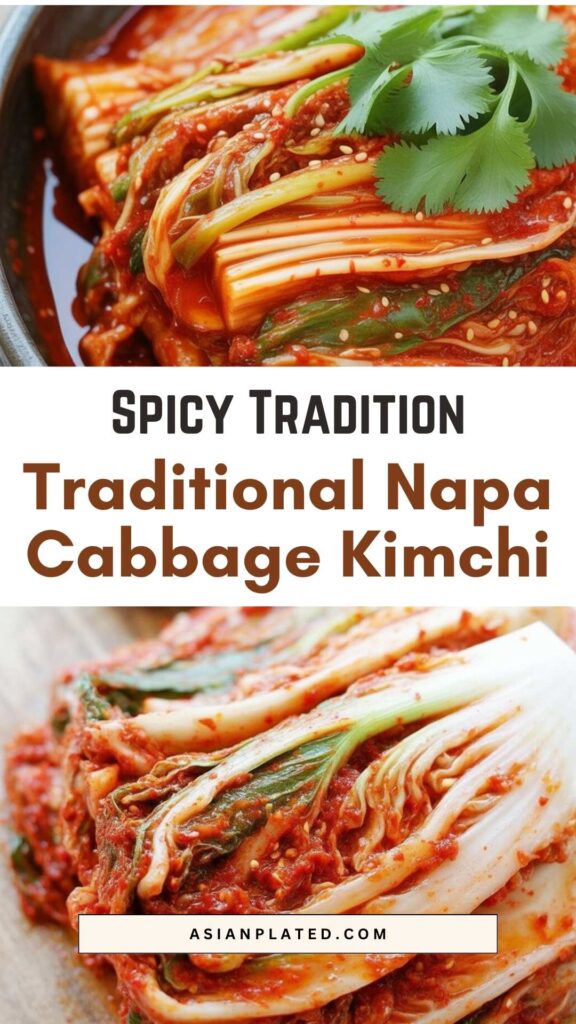
Variations
- Baek Kimchi (White Kimchi): A non-spicy version with no chili flakes, flavored with fruits and mild aromatics.
- Bossam Kimchi: Wrapped with whole cabbage leaves and stuffed with a seasoned filling.
- Young Summer Kimchi: Made with smaller, more tender cabbage heads for a quicker fermentation.
- Vegan Kimchi: Skip all seafood-based seasonings and use soy sauce or miso for depth.
FAQ
Do I have to use Korean chili flakes?
Yes for the authentic taste and color. Other chili powders can be too hot or have the wrong texture.
Why is my kimchi too salty?
It’s usually from over-salting during the brining stage. Rinse the cabbage well before adding seasoning.
Can I ferment kimchi at room temperature?
Yes — just for the first day or two. Then move it to the fridge to slow fermentation and preserve crunch.
What if I don’t have saeujeot or fish sauce?
Use soy sauce, miso paste, or skip entirely for a milder taste.
Traditional Napa Cabbage Kimchi
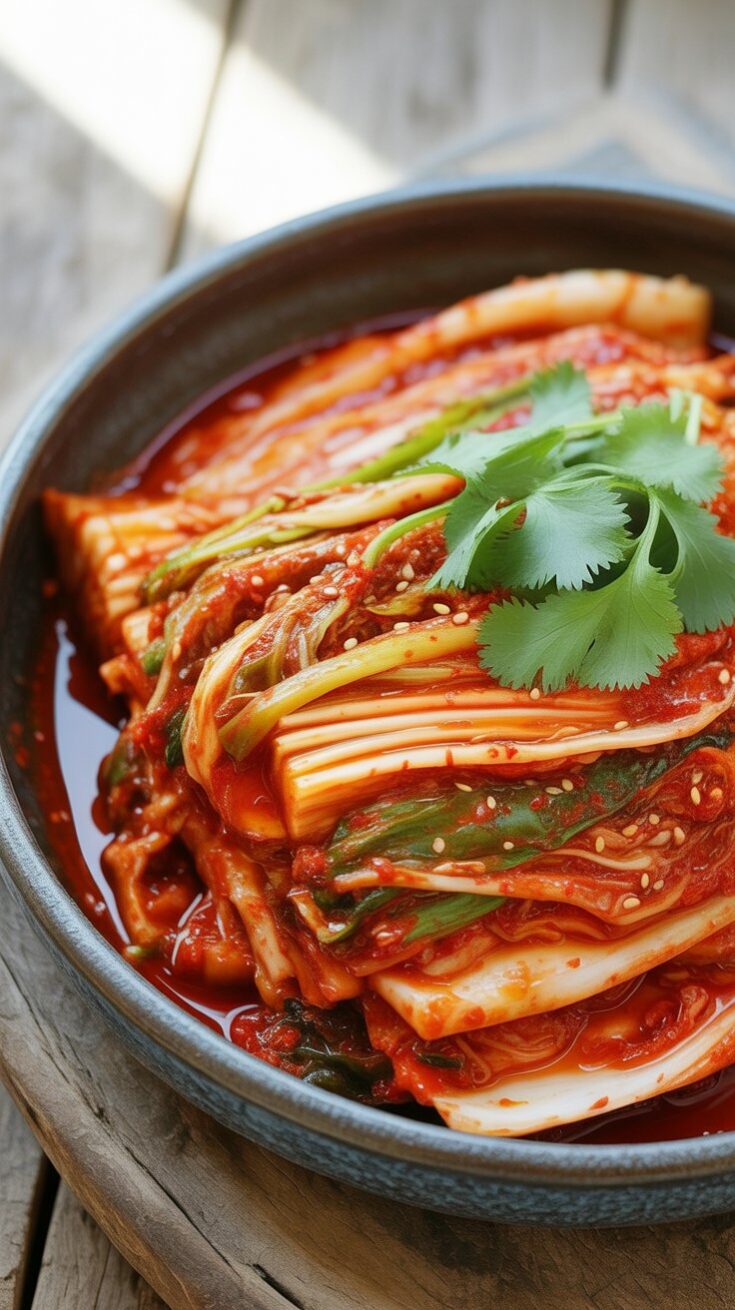
Bring the bold, tangy, and spicy flavors of Korea into your kitchen with this Traditional Kimchi recipe.
Ingredients
Vegetables & Base
- 1 large Napa cabbage (5–6 lbs) or 2 small ones (~3 lbs each)
- 1 lb Korean radish (mu)
- 3–4 scallions
- 1/4 large Korean pear (optional)
Salting & Brining
- 1 cup Korean coarse sea salt (gulgeun soguem)
- 5 cups water
Seasoning Paste
- 1/2 cup gochugaru (Korean red chili flakes), adjust to taste
- 3 tbsp fish sauce (myulchiaekjeot)
- 1/4 cup salted and fermented shrimp (saeujeot), roughly chopped
- 3 tbsp minced garlic
- 1 tsp grated ginger
- 3–4 raw shrimp, finely minced (optional)
- 1 tbsp glutinous rice flour
- 1/2 cup water or kelp broth (dasima)
Optional Kelp Broth
- 1 piece dried kelp (2–3 inch square)
Instructions
- Begin by halving the Napa cabbage lengthwise, then gently tear each half into quarters, keeping the leaves attached at the base. Dissolve half of the sea salt in the water and dip each cabbage quarter in the brine, shaking off excess liquid.
- Sprinkle the remaining salt between the thick white ribs of the leaves, ensuring even coverage. Arrange the cabbage in a large container, pour over the remaining brine, and let it rest for 6–8 hours, flipping the bottom pieces to the top every few hours.
- Once the white ribs bend without breaking, rinse the cabbage thoroughly three times, focusing between the leaves. Drain cut-side down while you prepare the seasoning.
- If making kelp broth, simmer the kelp in 1.5 cups water for about 5 minutes, then remove and let cool. Whisk the glutinous rice flour with 1/2 cup broth (or water) over low heat until it forms a thin paste, then cool completely.
- Cut the radish and optional pear into matchsticks, and slice the scallions diagonally into 1-inch pieces. In a large bowl, mix the gochugaru, fish sauce, saeujeot, garlic, ginger, minced shrimp (if using), rice paste, and 1/2 cup broth or water until thick and vibrant. Add the radish and pear, tossing until coated, then mix in scallions. Taste and adjust saltiness if needed. Let it rest for 30 minutes so the flavors meld.
- Trim off the tough stem ends from the cabbage quarters, keeping enough to hold the leaves together. Spread the seasoning mixture leaf by leaf over each cabbage quarter, using roughly a quarter of the mixture per piece. Fold the leaves inward toward the stem and wrap with the outer leaf.
- Pack the kimchi tightly into an airtight container, pressing down to remove air pockets. Rinse any remaining seasoning from the mixing bowl with a little water or broth and pour it over the top. Cover and let it ferment at room temperature for 1–2 days, depending on desired sourness, then store in the refrigerator.
- For the best flavor, allow it to mature in the fridge for at least 2 weeks before enjoying
Nutrition Information:
Yield: 36 Serving Size: 1Amount Per Serving: Calories: 29Total Fat: 0gSaturated Fat: 0gTrans Fat: 0gUnsaturated Fat: 0gCholesterol: 8mgSodium: 3311mgCarbohydrates: 5gFiber: 1gSugar: 1gProtein: 2g
Asianplated.com, occasionally offers nutritional information for recipes contained on this site. This information is provided as a courtesy and is an estimate only. This information comes from online calculators. Although allchickenrecipes.com attempts to provide accurate nutritional information, these figures are only estimates.
Final Thoughts
Making traditional kimchi at home might seem like a big project, but once you try it, it becomes part of your cooking rhythm. It’s one of those foods that’s more than just a dish — it’s a living, evolving flavor that changes week to week. Whether you’re eating it fresh with hot rice or months later in a bubbling jjigae, it’s always comforting, always familiar, and always worth having in your fridge.
Try other Korean recipes:

